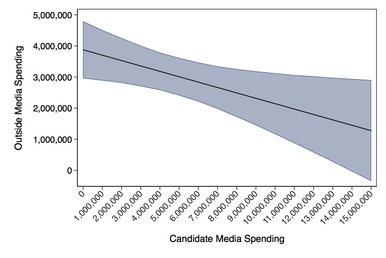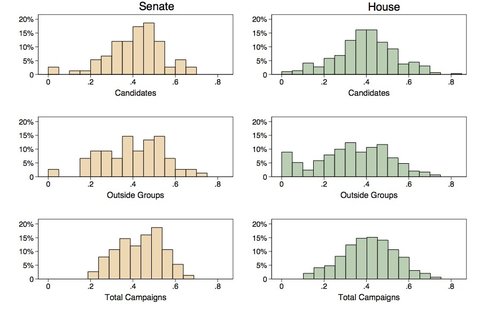Kenneth M. Miller
Cooperative Campaigns
This line of research explores how party networks have successfully adapted to current campaign rules. I find that candidates, parties, and most independent expenditure groups are willing and efficient partners in trusted networks who are able to divide the labor of campaigns and take advantage of one another's particular strengths despite legal barriers to explicit coordination. The consequence of this division of labor is more policy-oriented attack advertising and more national and less local-specific issue agendas. As outsiders take on greater roles in campaigns, campaigns become more informative for citizens, but also less tailored to local concerns and individual candidates' backgrounds and characteristics.
The Divided Labor of Attack Advertising in Congressional Campaigns. 2019. The Journal of Politics 81(3): 805-819
In this article I specify how candidates and outside groups divide the labor of attack advertising in campaigns. An analysis of the tone of all broadcast television political advertisements in the 2010 and 2012 congressional elections shows that as outside groups come into a campaign they "carry the negative," primarily attacking opponents and allowing candidates to reduce their own proportion of advertising devoted to attack. In addition, attacks from outside groups are more likely than candidate-sponsored attacks to be policy-based attacks versus attacks on personal characteristics. These findings show that candidates benefit from this relationship with outside groups by being shielded from potential backlash. Furthermore, this compensatory arrangement mutes the degree to which outsiders make campaigns more negative, and when outsiders take a greater role in campaigns those campaigns will be more focused on policy matters and less focused on personal aspects of the candidates.
| attack_ads_km.pdf |
Cooperative Media Spending in Senate Campaigns Post-Citizens United. 2017. The Forum (15)2: 269-289

This article investigates whether independent groups distribute media expenditures in ways that mirror the objectives of parties, or if divergent interests cause independent groups to allocate these funds differently. Using a large original dataset of media spending in Senate campaigns from 2010 through 2014, this study specifies how a seat-maximizing strategy goes beyond simply directing money to the most competitive contests; it compensates for candidates with insufficient cash to meet the media demands of their race and passes by candidates with more ample resources. Holding other factors constant, as candidate spending on media decreases, outside group media spending in support increases. The observed pattern of outside group resource allocation reveals that outside group activity in the aggregate is consistent with the seat-maximizing strategy expected of parties and demonstrates precise knowledge of campaign conditions. One subgroup of outsiders however, issue-based independent groups, still seek out the closest contests but are not sensitive to candidate budgets.
| miller_forum.pdf |
Cooperative Issue Agendas in Congressional Campaigns

Do outside groups represent independent interests injecting their issue agendas into campaigns or are they fully cooperative members of a partisan network of actors? This paper expands on the theory of compensatory cooperation between campaign actors to explain the division of the issues in campaigns. Based on an analysis of campaign advertising in the 2010 and 2012 congressional elections, it is shown that the sum of candidate and outsider advertising more closely matches the prevailing theories of campaign agendas than candidate or outsider advertising alone. Along with interviews of campaign professionals, these findings support the expectation that despite prohibitions on direct communication, candidates and outside groups successfully cooperate in crafting a coherent campaign agenda.